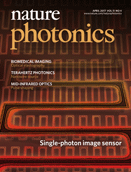Advertisement |
 |
Combined Spectrometer / Microscope
Time-resolved fluorescence spectroscopy is a valuable tool for investigating excited state dynamics in semiconductors. By interfacing a spectrometer like the FluoTime 300 with a microscope such as the MicroTime 100, one can easily record time-, space-, and spectrally resolved luminescence spectra.
Find out what happens within your sample! |  | | |
 |
 |
TABLE OF CONTENTS
|
April 2017 Volume 11, Issue 4 |
 |  |  |
 |  Editorial Editorial
 Research Highlights Research Highlights
 News and Views News and Views
 Correction Correction
 Progress Article Progress Article
 Letters Letters
 Articles Articles
 Erratum Erratum
| |
 |
|
 |
 |
| Advertisement |
 |
| |
 |
| |
Editorial |  Top Top |
 |
 |
 |
Photonics West 2017 p207
doi:10.1038/nphoton.2017.48
Excitement over positive industry forecasts, high attendance and a quality programme was dampened by travel restrictions to the United States.
|
 |
Research Highlights |  Top Top |
 |
 |
 |
Interferometry: Gravitational phase shift | Imaging: Gas leak detection | Biomedical optics: Blood monitoring | Optical communications: Gigabit lighting link | Metasurfaces: Chiral spectrometer |
News and Views |  Top Top |
 |
 |
 |
|
Correction |  Top Top |
 |
 |
 |
Correction p214
doi:10.1038/nphoton.2017.54
|
 |
Progress Article |  Top Top |
 |
 |
 |
The emergence of optical elastography in biomedicine pp215 - 221
Brendan F. Kennedy, Philip Wijesinghe and David D. Sampson
doi:10.1038/nphoton.2017.6
The principles and applications of optical elastography for use in biological imaging are reviewed.
|
 |
Letters |  Top Top |
 |
 |
 |
Generation and multi-octave shaping of mid-infrared intense single-cycle pulses pp222 - 226
Peter Krogen, Haim Suchowski, Houkun Liang, Noah Flemens, Kyung-Han Hong et al.
doi:10.1038/nphoton.2017.34
The conversion of shaped near-infrared pulses to shaped, energetic, multi-octave-spanning mid-infrared pulses lasting as little as 1.2 optical cycles is made possible by adiabatic difference frequency generation.
|
 |
 |
 |
Symmetry-controlled temporal structure of high-harmonic carrier fields from a bulk crystal pp227 - 231
F. Langer, M. Hohenleutner, U. Huttner, S. W. Koch, M. Kira et al.
doi:10.1038/nphoton.2017.29
The temporal structure of the polarization and carrier-envelope phase slip of high-harmonic waveforms generated in bulk gallium selenide within the duration of a single multi-terahertz driving pulse can be controlled by the crystal symmetry.
|
 |
 |
 |
Anisotropy-induced photonic bound states in the continuum pp232 - 236
Jordi Gomis-Bresco, David Artigas and Lluis Torner
doi:10.1038/nphoton.2017.31
Existence conditions of bound states within the continuum of radiative modes are revealed for waveguides with anisotropic birefringent materials.
See also: News and Views by Kivshar & Rybin |
 |
 |
 |
Spatial beam self-cleaning in multimode fibres pp237 - 241
K. Krupa, A. Tonello, B. M. Shalaby, M. Fabert, A. Barthélémy et al.
doi:10.1038/nphoton.2017.32
The Kerr effect in graded-index multimode fibres drives a spatial beam self-cleaning phenomenon that withstands fibre bending and does not necessitate dissipative processes such as stimulated scattering.
|
 |
| Advertisement |
 |
An open access, online-only, multidisciplinary research journal dedicated to publishing the most important scientific advances in the life sciences, physical sciences, and engineering fields that are facilitated by spaceflight and analogue platforms.
Explore the benefits of submitting your next research article. |  | | |
 |
| |
Articles |  Top Top |
 |
 |
 |
Femtosecond-laser-driven wire-guided helical undulator for intense terahertz radiation pp242 - 246
Ye Tian, Jiansheng Liu, Yafeng Bai, Shiyi Zhou, Haiyi Sun et al.
doi:10.1038/nphoton.2017.16
Terahertz (THz) pulses are generated by irradiating a metal wire with femtosecond laser pulses. For incident laser energy of 3 mJ, a THz pulse with energy of 28 µJ is obtained from a 10-cm-long wire. The spectrum of the THz pulse covers 0.1–1.5 THz.
|
 |
 |
 |
Single-photon imager based on a superconducting nanowire delay line pp247 - 251
Qing-Yuan Zhao, Di Zhu, Niccolò Calandri, Andrew E. Dane, Adam N. McCaughan et al.
doi:10.1038/nphoton.2017.35
A superconducting nanowire acting as a single-photon detector and as a microwave delay line is used to demonstrate an imaging device at the single-photon level with sub-20-µm spatial resolution and 50-ps temporal resolution.
|
 |
 |
 |
Space–time control of free induction decay in the extreme ultraviolet pp252 - 258
S. Bengtsson, E. W. Larsen, D. Kroon, S. Camp, M. Miranda et al.
doi:10.1038/nphoton.2017.30
The spatial phase and direction of extreme-ultraviolet light are controlled by an all-optical modulator based on argon gas. It works by using an infrared pulse to control the spatial and spectral phase of the free induction decay in the gas system.
See also: News and Views by Sekikawa & Ishikawa |
 |
 |
 |
Subwavelength coherent imaging of periodic samples using a 13.5 nm tabletop high-harmonic light source pp259 - 263
Dennis F. Gardner, Michael Tanksalvala, Elisabeth R. Shanblatt, Xiaoshi Zhang, Benjamin R. Galloway et al.
doi:10.1038/nphoton.2017.33
Coherent diffractive imaging of periodic samples is demonstrated with a tabletop, 13.5 nm high-harmonic source. With a novel image reconstruction technique, the record high spatial resolution of 12.6 nm is achieved in the extreme-ultraviolet region.
|
 |
Erratum |  Top Top |
 |
 |
 |
Erratum: Near-zero refractive index photonics p264
Iñigo Liberal and Nader Engheta
doi:10.1038/nphoton.2017.38
|
 |
 Top Top |
 |
 |
 |  |  |  |  |  | Natureevents is a fully searchable, multi-disciplinary database designed to maximise exposure for events organisers. The contents of the Natureevents Directory are now live. The digital version is available here.
Find the latest scientific conferences, courses, meetings and symposia on natureevents.com. For event advertising opportunities across the Nature Publishing Group portfolio please contact natureevents@nature.com |  |  |  |  |  |
|
 |


No comments:
Post a Comment